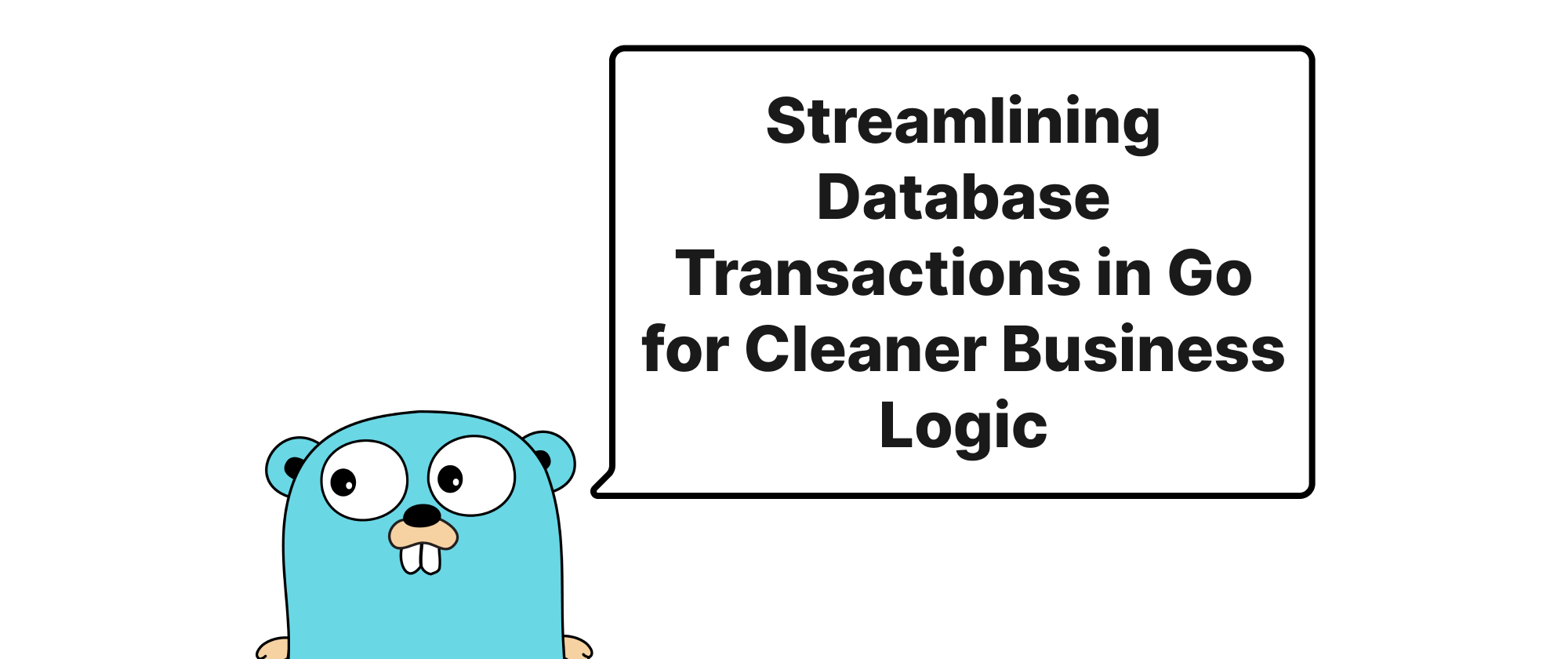Streamlining Database Transactions in Go for Cleaner Business Logic
Olivia Novak
Dev Intern · Leapcell

Introduction
In modern applications, database interactions are omnipresent. Many critical operations, such as transferring funds, registering a new user, or placing an order, involve sequences of database modifications that must either all succeed or all fail together. This "all or nothing" principle is the cornerstone of database transactions, ensuring data integrity and consistency. However, directly managing transactions in application code can quickly become cumbersome, leading to duplicated boilerplate, error-prone rollback logic, and tangled business logic. This article explores how to design a clean and concise Go function to encapsulate database transaction management, allowing developers to focus purely on the business operations within the transaction, thereby simplifying code and improving maintainability.
Core Concepts Before We Start
Before diving into the implementation, let's briefly define some core concepts that are fundamental to understanding the approach we'll be discussing:
- Database Transaction: A single unit of work that ensures a set of operations are treated as a whole. It obeys ACID properties (Atomicity, Consistency, Isolation, Durability).
- Atomicity: Guarantees that all operations within a transaction are completed successfully; otherwise, the transaction is aborted at the point of failure, and all operations are rolled back to their state before the transaction began.
- Rollback: The process of undoing all changes made during a transaction if any part of it fails.
- Commit: The process of making all changes made during a transaction permanent in the database.
- Context in Go: A
context.Contextcarries deadlines, cancellation signals, and other request-scoped values across API boundaries and to goroutines. It's crucial for managing timeouts and cancellations within a transaction. *sql.Txand*sql.DB: In Go'sdatabase/sqlpackage,*sql.DBrepresents a connection pool to a database, while*sql.Txrepresents an ongoing database transaction.
Encapsulating Transactions for Simplified Business Logic
The primary goal is to abstract away the boilerplate associated with starting, committing, and rolling back transactions. We want a function that takes our business logic as an argument and handles the transaction lifecycle around it. This keeps our business logic clean, declarative, and free from transaction management details.
The Problem with Manual Transaction Management
Consider a typical scenario without proper encapsulation:
func transferFundsManual(db *sql.DB, fromAccountID, toAccountID int, amount float64) error { tx, err := db.Begin() if err != nil { return fmt.Errorf("failed to begin transaction: %w", err) } defer func() { if r := recover(); r != nil { tx.Rollback() // Rollback on panic panic(r) } }() _, err = tx.Exec("UPDATE accounts SET balance = balance - $1 WHERE id = $2", amount, fromAccountID) if err != nil { tx.Rollback() return fmt.Errorf("failed to debit account: %w", err) } _, err = tx.Exec("UPDATE accounts SET balance = balance + $1 WHERE id = $2", amount, toAccountID) if err != nil { tx.Rollback() return fmt.Errorf("failed to credit account: %w", err) } if err := tx.Commit(); err != nil { tx.Rollback() // Though commit error should ideally trigger rollback by DB return fmt.Errorf("failed to commit transaction: %w", err) } return nil }
This simple function already contains significant boilerplate: db.Begin(), multiple tx.Rollback() calls, and tx.Commit(). Any additional operation would require another if err != nil { tx.Rollback() } block. This repetitive code is a prime candidate for abstraction.
Designing the Transaction Wrapper Function
We can create a higher-order function that accepts a context.Context, a *sql.DB instance, and a function representing the transactional business logic. This business logic function will operate on a *sql.Tx instance.
package database import ( "context" "database/sql" "fmt" ) // TxFunc defines the signature for a function that performs operations within a transaction. // It receives a transaction object (*sql.Tx) and returns an error if any operation fails. type TxFunc func(ctx context.Context, tx *sql.Tx) error // WithTransaction executes the given TxFunc within a new database transaction. // It handles starting the transaction, committing it on success, and rolling it back on error. // The provided context is passed to the TxFunc and is used for transaction operations if applicable. func WithTransaction(ctx context.Context, db *sql.DB, fn TxFunc) error { tx, err := db.BeginTx(ctx, nil) // begin transaction with context if err != nil { return fmt.Errorf("failed to begin transaction: %w", err) } // Defer a function to handle commit or rollback based on the function's outcome. // This ensures transaction resolution regardless of how `fn` exits (return, panic). defer func() { if p := recover(); p != nil { // A panic occurred, so rollback the transaction and re-panic. // Re-panicking propagates the original panic. if rollbackErr := tx.Rollback(); rollbackErr != nil { fmt.Printf("panic during transaction, rollback failed: %v, original panic: %v\n", rollbackErr, p) } else { fmt.Printf("panic during transaction, transaction rolled back, original panic: %v\n", p) } panic(p) } }() // Execute the business logic function with the transaction. err = fn(ctx, tx) if err != nil { // Business logic returned an error, so rollback the transaction. if rollbackErr := tx.Rollback(); rollbackErr != nil { return fmt.Errorf("transaction failed and rollback also failed: %w (original error: %w)", rollbackErr, err) } return fmt.Errorf("transaction rolled back: %w", err) } // Business logic succeeded, so commit the transaction. if err := tx.Commit(); err != nil { return fmt.Errorf("failed to commit transaction: %w", err) } return nil // Transaction committed successfully }
Explanation of the WithTransaction function:
func WithTransaction(ctx context.Context, db *sql.DB, fn TxFunc) error:- It takes
ctxfor context propagation (e.g., timeouts). - It takes
db *sql.DBto initiate the transaction. - It takes
fn TxFunc, which is the actual business logic to execute.
- It takes
tx, err := db.BeginTx(ctx, nil): Starts a new transaction.BeginTxis preferred overBeginas it accepts a context, allowing transaction initiation to respect deadlines or cancellations.defer func() { ... }(): Thisdeferblock is crucial. It intercepts panics that might occur within thefn(business logic), ensuring the transaction is rolled back before the panic propagates. This makes our transaction handling robust even in the face of unexpected runtime errors.err = fn(ctx, tx): Executes the user-provided business logic, passing it thecontextand the*sql.Txobject.- Error Handling (Rollback vs. Commit):
- If
fnreturns an error, the transaction is explicitly rolled back usingtx.Rollback(). We then wrap the original error and return it. - If
fncompletes without an error, the transaction is committed usingtx.Commit(). - Error handling for
RollbackandCommitcalls themselves is also included to provide more informative error messages.
- If
Applying the Wrapper to Business Logic
Now, let's refactor our transferFundsManual using WithTransaction:
package main import ( "context" "database/sql" "fmt" _ "github.com/lib/pq" // Example: PostgreSQL driver "log" "your_module_path/database" // Assuming database package is in your module ) // Account model (simple for this example) type Account struct { ID int Balance float64 } // transferFunds encapsulates the fund transfer logic within a transaction. func transferFunds(db *sql.DB, fromAccountID, toAccountID int, amount float64) error { return database.WithTransaction(context.Background(), db, func(ctx context.Context, tx *sql.Tx) error { // 1. Debit the sender's account result, err := tx.ExecContext(ctx, "UPDATE accounts SET balance = balance - $1 WHERE id = $2 AND balance >= $1", amount, fromAccountID) if err != nil { return fmt.Errorf("failed to debit account %d: %w", fromAccountID, err) } rowsAffected, _ := result.RowsAffected() if rowsAffected == 0 { // This could mean insufficient funds or invalid account ID return fmt.Errorf("failed to debit account %d: insufficient funds or account not found", fromAccountID) } // 2. Credit the receiver's account _, err = tx.ExecContext(ctx, "UPDATE accounts SET balance = balance + $1 WHERE id = $2", amount, toAccountID) if err != nil { return fmt.Errorf("failed to credit account %d: %w", toAccountID, err) } // If we reach here, both operations succeeded within the transaction, // and WithTransaction will handle the commit. return nil }) } func main() { // --- Database Setup (Example for PostgreSQL) --- // In a real application, you'd get this from configuration or dependency injection. connStr := "user=user dbname=testdb password=password host=localhost sslmode=disable" db, err := sql.Open("postgres", connStr) if err != nil { log.Fatalf("Error opening database: %v", err) } defer db.Close() // Ping the database to ensure connection is established err = db.Ping() if err != nil { log.Fatalf("Error connecting to the database: %v", err) } // Initialize table if it doesn't exist and insert some initial data setupDB(db) ctx := context.Background() // --- Test Successful Transfer --- fmt.Println("--- Attempting successful transfer ---") err = transferFunds(db, 1, 2, 50.0) if err != nil { log.Printf("Transfer successful (as expected): %v", err) } else { log.Println("Transfer successful!") } printAccountBalances(db) // --- Test Failed Transfer (Insufficient Funds) --- fmt.Println("\n--- Attempting failed transfer (insufficient funds) ---") err = transferFunds(db, 1, 2, 2000.0) // Account 1 only has 100 initially if err != nil { log.Printf("Transfer failed (as expected): %v", err) } else { log.Println("Transfer unexpectedly succeeded!") } printAccountBalances(db) // --- Test Failed Transfer (Simulated error in credit) --- fmt.Println("\n--- Attempting failed transfer (simulated error) ---") // For demonstration, let's modify TxFunc to force an error on credit for a specific condition. // In a real app, this would be an actual business rule or database error. err = database.WithTransaction(ctx, db, func(ctx context.Context, tx *sql.Tx) error { // Debit operation result, err := tx.ExecContext(ctx, "UPDATE accounts SET balance = balance - $1 WHERE id = $2", 10.0, 1) if err != nil { return fmt.Errorf("debit failed: %w", err) } rowsAffected, _ := result.RowsAffected() if rowsAffected == 0 { return fmt.Errorf("debit failed: account 1 not found or insufficient funds") } // Simulate an error during the credit operation return fmt.Errorf("simulated error during credit operation") // This will trigger a rollback }) if err != nil { log.Printf("Simulated transfer failed (as expected): %v", err) } else { log.Println("Simulated transfer unexpectedly succeeded!") } printAccountBalances(db) } // Utility function to set up database and initial data func setupDB(db *sql.DB) { _, err := db.Exec(` CREATE TABLE IF NOT EXISTS accounts ( id SERIAL PRIMARY KEY, balance NUMERIC(10, 2) NOT NULL DEFAULT 0.00 ); TRUNCATE TABLE accounts RESTART IDENTITY CASCADE; INSERT INTO accounts (id, balance) VALUES (1, 100.00), (2, 50.00), (3, 0.00); `) if err != nil { log.Fatalf("Failed to setup database: %v", err) } fmt.Println("Database setup complete with initial accounts.") } // Utility function to print current account balances func printAccountBalances(db *sql.DB) { rows, err := db.Query("SELECT id, balance FROM accounts ORDER BY id") if err != nil { log.Printf("Error querying balances: %v", err) return } defer rows.Close() fmt.Println("Current Account Balances:") for rows.Next() { var acc Account if err := rows.Scan(&acc.ID, &acc.Balance); err != nil { log.Printf("Error scanning account: %v", err) continue } fmt.Printf(" Account %d: %.2f\n", acc.ID, acc.Balance) } if err = rows.Err(); err != nil { log.Printf("Error iterating account rows: %v", err) } }
In the transferFunds function, the business logic is now much cleaner. It focuses solely on the debit and credit operations, receiving a *sql.Tx object directly. All transaction lifecycle management (begin, commit, rollback) is handled externally by WithTransaction. This greatly enhances readability and reduces the chances of errors like forgetting a tx.Rollback() call.
Benefits of this Approach
- Cleaner Business Logic: The core business operations are decoupled from transaction management boilerplate.
- Reduced Duplication: The transaction management logic is written once in
WithTransactionand reused everywhere. - Improved Robustness: Handles errors and panics gracefully, ensuring transactions are always properly closed (committed or rolled back).
- Easier Testing: Business logic functions become easier to test in isolation, potentially even with mock transaction objects.
- Consistency: All transactional operations adhere to the same management pattern, making the codebase more predictable.
- Context Awareness: Integrates
context.Contextfor cancellation and timeouts, making transactions more resilient in distributed systems.
Application Scenarios
This pattern is highly effective in several scenarios:
- Service Layer Operations: When a service method needs to perform multiple database writes that must be atomic.
- Command Handlers: In CQRS architectures, command handlers that modify state often benefit from transactional guarantees.
- Batch Processing: When processing a batch of items where each item's processing needs to be atomic, or a group of items needs to be processed transactionally.
- Any Operation Requiring ACID Properties: Fund transfers, order processing, complex data migrations, etc.
Conclusion
Encapsulating database transactions within a dedicated, concise Go function like WithTransaction significantly simplifies application code by abstracting away repetitive boilerplate. This pattern promotes cleaner business logic, enhances error handling, and ensures the consistent application of ACID properties, leading to more robust and maintainable data-driven applications. By adopting this approach, developers can focus on the "what" of their business processes rather than the "how" of transaction management, making code more readable and less prone to transaction-related errors.


